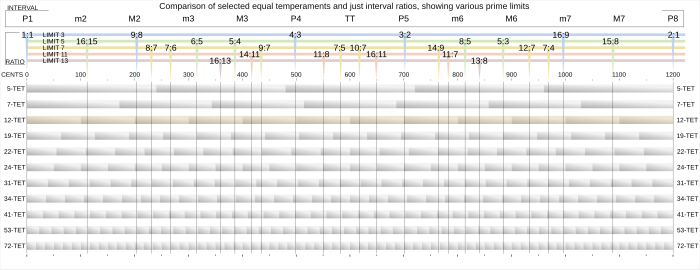
Back Темпериран строй Bulgarian Temperament igual Catalan Rovnoměrně temperované ladění Czech Ligesvævende temperatur Danish Gleichstufige Stimmung German Egalŝtupa agordo Esperanto Temperamento igual Spanish Võrdtempereeritud häälestus Estonian Tenperamentu berdin Basque اعتدال مساوی Persian

An equal temperament is a musical temperament or tuning system that approximates just intervals by dividing an octave (or other interval) into steps such that the ratio of the frequencies of any adjacent pair of notes is the same. This system yields pitch steps perceived as equal in size, due to the logarithmic changes in pitch frequency.[2]
In classical music and Western music in general, the most common tuning system since the 18th century has been 12 equal temperament (also known as 12 tone equal temperament, 12 TET or 12 ET, informally abbreviated as 12 equal), which divides the octave into 12 parts, all of which are equal on a logarithmic scale, with a ratio equal to the 12th root of 2, ( 12√2 ≈ 1.05946 ). That resulting smallest interval, 1/12 the width of an octave, is called a semitone or half step. In Western countries the term equal temperament, without qualification, generally means 12 TET.
In modern times, 12 TET is usually tuned relative to a standard pitch of 440 Hz, called A 440, meaning one note, A, is tuned to 440 hertz and all other notes are defined as some multiple of semitones away from it, either higher or lower in frequency. The standard pitch has not always been 440 Hz; it has varied considerably and generally risen over the past few hundred years.[3]
Other equal temperaments divide the octave differently. For example, some music has been written in 19 TET and 31 TET, while the Arab tone system uses 24 TET.
Instead of dividing an octave, an equal temperament can also divide a different interval, like the equal-tempered version of the Bohlen–Pierce scale, which divides the just interval of an octave and a fifth (ratio 3:1), called a "tritave" or a "pseudo-octave" in that system, into 13 equal parts.
For tuning systems that divide the octave equally, but are not approximations of just intervals, the term equal division of the octave, or EDO can be used.
Unfretted string ensembles, which can adjust the tuning of all notes except for open strings, and vocal groups, who have no mechanical tuning limitations, sometimes use a tuning much closer to just intonation for acoustic reasons. Other instruments, such as some wind, keyboard, and fretted instruments, often only approximate equal temperament, where technical limitations prevent exact tunings.[4] Some wind instruments that can easily and spontaneously bend their tone, most notably trombones, use tuning similar to string ensembles and vocal groups.
- ^ Sethares (2005), fig. 4.6, p. 58
- ^ O'Donnell, Michael. "Perceptual Foundations of Sound". Retrieved 11 March 2017.
- ^ Helmholtz, H.; Ellis, A.J. "The History of Musical Pitch in Europe". On the Sensations of Tone. Translated by Ellis, A.J. (reprint ed.). New York, NY: Dover. pp. 493–511.
- ^ Varieschi, Gabriele U.; Gower, Christina M. (2010). "Intonation and compensation of fretted string instruments". American Journal of Physics. 78 (1): 47–55. arXiv:0906.0127. Bibcode:2010AmJPh..78...47V. doi:10.1119/1.3226563. S2CID 20827087.
Cite error: There are <ref group=lower-alpha> tags or {{efn}} templates on this page, but the references will not show without a {{reflist|group=lower-alpha}} template or {{notelist}} template (see the help page).
© MMXXIII Rich X Search. We shall prevail. All rights reserved. Rich X Search

